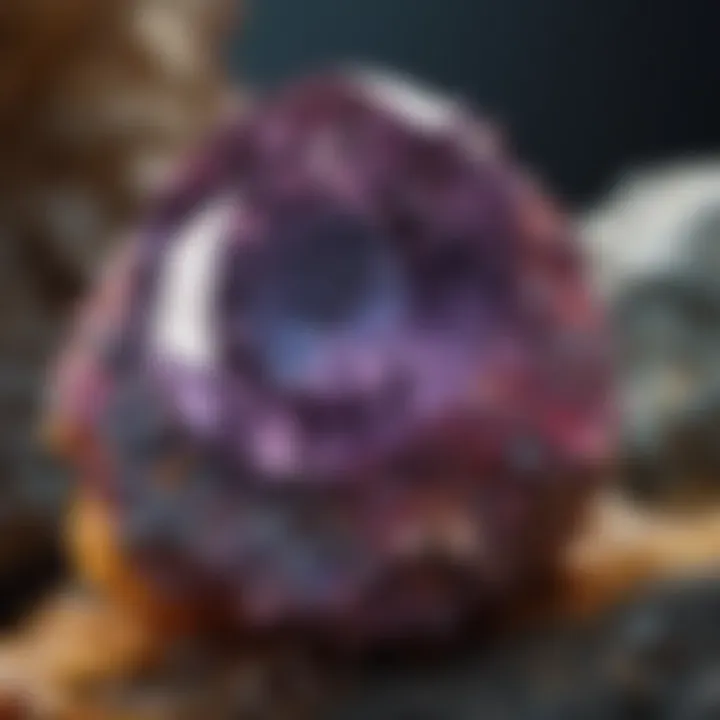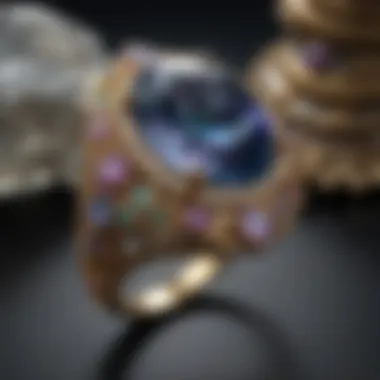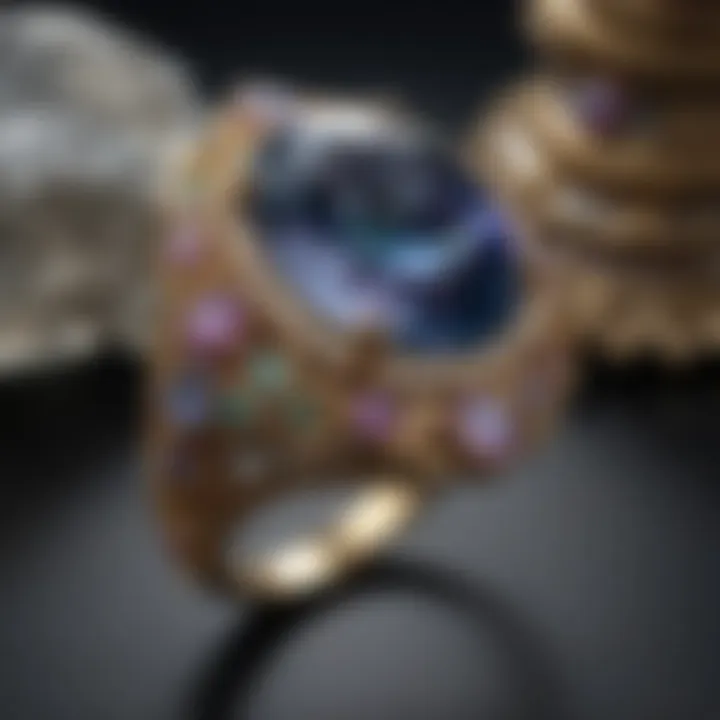Understanding True Alexandrite: Properties, Origins, and Value


Gemstone Overview
Definition and Characteristics
Alexandrite, a rare gemstone belonging to the chrysoberyl family, is celebrated for its unique ability to change color under different lighting conditions. This phenomenon, known as the color-change effect, exhibits shades of green in daylight and transforms into shades of red or purplish-red under incandescent light. The mineral composition of true alexandrite includes aluminum, beryllium, and chromium, which contribute to its distinct hues. True alexandrite is often found in significant clarity, making it highly sought after in the jewelry market.
In terms of value, true alexandrite is amongst the most coveted gemstones, often trading for prices far exceeding that of diamonds. This high value stems from its scarcity and the extraordinary beauty it commands.
Classification of Gemstones
Gemstones can be classified based on various criteria, such as formation, chemical composition, or clarity. True alexandrite is classified as a natural gemstone, distinguishing it from synthetics and simulants. Natural gemstones are those that have undergone geological processes over millions of years, unlike synthetics such as created alexandrite, which can mimic the properties of natural stones but lack the geological history. Collectors and enthusiasts must therefore be discerning in their choices to ensure they acquire genuine specimens.
Historical Significance
Ancient Uses and Cultural Importance
The history of alexandrite is rich and tied to its discovery in the Ural Mountains of Russia in the early 19th century. Named after Tsar Alexander II, it quickly became a favorite among Russian nobility. To this day, it is associated with wealth and luxury. Historically, gemstones such as alexandrite have been used in jewelry, but they also held significance in ancient beliefs. They were often thought to bring good luck, health, and protection to their wearers.
Myths and Legends Surrounding Gemstones
Throughout history, alexandrite has been enveloped in various myths. It is said to symbolize balance and self-esteem, and in some cultures, it is known as a stone of renewal. Many believe that its transformative color reflects the duality of life experiences. The allure of alexandrite is not limited to its beauty; its historical mystique enhances its value and appeal in today’s gemstone market.
"True alexandrite, with its captivating color shift, serves as a reminder of nature's hidden wonders and the stories gemstones can tell through time."
In summary, understanding true alexandrite involves appreciating its unique properties, historical relevance, and desirability in the market. This knowledge serves as a foundation for anyone interested in collecting or designing with this remarkable gemstone.
Prologue to True Alexandrite
True alexandrite is one of the most captivating gemstones, known for its distinct color change phenomenon. This unique property allows it to display a green hue in daylight and a purplish-red shade under incandescent light. The allure of true alexandrite captivates not only collectors and jewelry enthusiasts but also anyone interested in the natural marvels of the Earth.
The significance of this gemstone extends beyond aesthetics. Its rarity makes it a sought-after jewel for wise investments in the gemstone market. Understanding its properties and origins provides collectors with vital knowledge necessary for making informed purchasing decisions. True alexandrite serves as a compelling study in both geology and gemology, bridging the gap between science and art.
When discussing true alexandrite, several key aspects merit attention:
- Geological Origins: The geological conditions leading to the formation of alexandrite are unique and complex. This section will delve into the specifics of its formation, shedding light on the mineral's journey from earth to gem.
- Physical Properties: Understanding the physical and chemical properties of true alexandrite, including its exceptional hardness and unique color-changing ability, is essential for distinguishing it from imitations.
- Historical Significance: The rich history associated with alexandrite adds another layer of fascination. From royal adornments to cultural symbolism, alexandrite has left an indelible mark on history.
- Market Trends: Current market trends and factors influencing the value of true alexandrite offer valuable insight for both collectors and investors.
In this article, we aim to provide a comprehensive guide to true alexandrite, discussing its properties, geological origins, and market aspects. The information presented here will serve as an invaluable resource for gemstone enthusiasts and collectors keen to deepen their understanding of this remarkable gem and its value in the market.
Geological Origins of Alexandrite
Understanding the geological origins of alexandrite is essential to grasp its rarity and value. The conditions required for its formation are quite specific, making the contexts in which it is found equally significant. Each location influences the resulting stone's characteristics, such as color and inclusions. Knowing the geological factors can help collectors and enthusiasts appreciate not only the beauty of alexandrite but also the story behind its existence.
Formation Process
Alexandrite forms under unique conditions that combine heat, pressure, and specific chemical environments. The mineral belongs to the chrysoberyl family and specifically contains elements like aluminum and beryllium. When these components crystallize deep within the Earth, the conditions have to align perfectly to create the outstanding optical properties that make alexandrite special. The most striking feature of alexandrite is its ability to change color depending on the light source, a result of its unique crystal structure and composition. This fascinating process of formation contributes to the overall value.
Primary Locations
The primary sources of alexandrite are Brazil, Russia, and East Africa. Each location presents distinct qualities that contribute to the gemstone’s desirability.
Brazil
Brazil is often recognized for producing the most sought-after alexandrites. The stones from this region generally display a more intense color change, often shifting from a vibrant green in daylight to a warm reddish hue under incandescent light. This remarkable color shift is what makes Brazilian alexandrite highly prized among collectors. The geological conditions in Brazil provided an environment conducive to the growth of beautiful stones. However, the supply of true Brazilian alexandrite has diminished over the years, which has added to its desirability and market value.


Russia
Russian alexandrite emerged during the early 19th century and became famous due to its association with royal families. The most notable deposits came from the Ural Mountains. The stones are often characterized by a distinct color change and clarity that rival those from Brazil. The scarcity of high-quality alexandrite from Russia, combined with its historical significance, has established its position as a valuable choice for collectors. However, Russian alexandrite is less frequently found in today’s market, which raises its value even higher.
East Africa
In recent decades, East Africa, particularly countries like Madagascar and Tanzania, has gained attention for alexandrite mining. The stones from this region often exhibit a mix of qualities from both Brazilian and Russian counterparts. They can show appealing color changes, but the overall gem quality might not always match the high standards set by their predecessors. The more accessible nature of East African alexandrite offers opportunities for collectors looking for pieces that are both beautiful and more affordable. However, the consistency in quality can vary significantly, which should be considered when investing.
Physical and Chemical Properties
Understanding the physical and chemical properties of true alexandrite is crucial. These characteristics determine not just its beauty, but also its value and practicality as a gemstone. The allure of alexandrite lies in its unique attributes that differentiate it from other gemstones.
Unique Color Change
One of the most notable features of alexandrite is its unique color change effect. This phenomenon occurs due to the mineral's crystal structure, which allows it to exhibit different colors depending on the lighting. In daylight or fluorescent light, alexandrite typically appears green to bluish-green. Under incandescent light, it shifts to shades of red or purplish-red. This remarkable ability to change color can greatly enhance its desirability and value in the market.
Crystal Structure
Alexandrite crystallizes in the orthorhombic system. Its structure allows light to interact with the mineral in a way that enhances its unique color attributes. Notably, the quality of its crystal formation can affect the visual appearance. Well-formed crystals lead to better clarity and color display, while imperfections can detract from its overall appeal. The specific arrangement of atoms within the crystal lattice influences the light absorption characteristics, which ultimately contributes to its remarkable color-change ability.
Hardness and Durability
In terms of durability, true alexandrite scores a 8.5 on the Mohs scale, indicating a strong resistance to scratching. This hardness makes it suitable for various types of jewelry, from rings to necklaces. However, while it is durable, proper care is still essential to maintain its luster and brilliance. Additionally, its toughness is generally considered good, but care is still advisable to prevent chipping, especially in settings where it may be exposed to harsh conditions.
The combination of unique color change, crystal structure, and durability makes true alexandrite not only a gem of beauty but also a valuable and practical choice for collectors and jewelry designers alike.
Distinguishing True Alexandrite from Imitations
Understanding the differences between true alexandrite and its imitations is crucial for anyone interested in gemstones. True alexandrite possesses distinct properties that contribute to its rarity and value. This section offers a detailed examination of common imitations and verification techniques to help collectors and enthusiasts make informed decisions.
Common Imitations
Synthetic Alexandrite
Synthetic alexandrite is a laboratory-created gemstone that mimics the qualities of natural alexandrite. One key characteristic is its ability to display color change, similar to its natural counterpart. Synthetic stones are often favored for their availability and affordability compared to natural ones.
However, there are notable differences. Synthetic alexandrite typically has fewer internal imperfections, which can be an advantage in terms of clarity but can also make it less desirable for collectors seeking natural stones. Moreover, as technology improves, discerning these synthetics from the natural stones has become more difficult, making understanding their characteristics essential for buyers.
Color-Changing Stones
Color-changing stones, such as certain types of garnet or other minerals, can also be misleading for those looking for true alexandrite. These stones display a color shift, but the hues and intensity generally differ from genuine alexandrite. Typically, such stones might shift from brownish to green, lacking the vibrant tones of true alexandrite.
The benefit of these alternatives is often lower cost and wider availability in the market. However, buyers need to be cautious as these stones do not hold the same value or significance as authentic alexandrite. Understanding the specific color-changing characteristics can aid in making an educated purchase that aligns with collectors' goals.
Verification Techniques
To avoid pitfalls in purchasing, several verification techniques exist. One common method is to examine the stone under various lighting conditions. True alexandrite exhibits a shift from green in daylight to a red hue under incandescent light. Additionally, professional gemological examinations can confirm authenticity. Gemologists use tools to assess inclusions, color quality, and other features that distinguish true alexandrite.
"Recognizing the unique properties of true alexandrite can significantly affect both value and satisfaction in gemstone collecting."
Investors and collectors alike should prioritize these verification methods to ensure their collections contain only genuine stones.
Historical Significance of Alexandrite
Alexandrite is not merely a gemstone; it embodies a rich historical narrative that spans various cultures and epochs. Its discovery and subsequent adoption into jewelry trace back to its enchanting color-changing properties that captivated both the elite and common folk. This section offers insights into why alexandrite holds a significant place in history and culture, with particular emphasis on its cultural impact and illustrious connections to royalty.


Cultural Impact
The impact of alexandrite extends beyond its aesthetic beauty; it resonates deeply within various cultural contexts. Initially discovered in the emerald-rich region of Russia, alexandrite became a symbol of wealth and luxury.
- Symbol of Change: The gemstone's unique ability to shift colors from green in sunlight to red under incandescent light serves as a metaphor for transformation and adaptability, resonating with numerous philosophical themes across different cultures.
- Folk Beliefs: In some traditions, alexandrite is believed to bring luck, prosperity, and protection. Its rarity adds to this allure, often considered a stone of the fortunate.
- Artistic Inspiration: The vibrant hues of alexandrite have also inspired various forms of art and literature, contributing to its cultural footprint. Artists have sought to replicate its colors in various art forms, thereby embedding it in the visual lexicon.
Alexandrite in Royal History
Throughout history, alexandrite has found its way into royal collections, becoming a favored gem among monarchs due to its striking appearance and unique properties.
"Alexandrite can be seen as a reflection of one's status and taste, particularly within royalty, where the possession of rare gemstones signified power and affluence".
- Imperial Favor: The stone was named after Tsar Alexander II of Russia, symbolizing its royal connection. This association is significant, as it highlights the esteem in which the gemstone was held among the Russian aristocracy.
- Regal Jewelry: Many pieces of jewelry crafted for royalty featured alexandrite, often set alongside diamonds and other precious stones. This not only showcased the beauty of the gem but also signified the wealth of the wearer.
- An Enduring Legacy: As a result, alexandrite has become a part of many royal heritages, with pieces being passed down through generations. Such history contributes to the value and desirability of true alexandrite today.
Metaphysical Properties
Metaphysical properties of true alexandrite are often discussed among collectors and enthusiasts. People believe that gemstones carry energies and vibrations that can influence our emotions and lives. Hence, many consider true alexandrite to be more than just a beautiful stone; they see it as an entity rich in meaning and significance.
Symbolism and Meaning
True alexandrite symbolizes change and transformation. This connection arises from its remarkable color-changing ability, where it shifts from green in daylight to red under incandescent light. This duality resonates with ideas of adaptability and balance in life, encouraging people to embrace transitions.
Historically, this gem has been viewed as a protector amid life's uncertainty. Ancient cultures placed high value on alexandrite, often associating it with good fortune and prosperity. Due to these associations, many believe wearing alexandrite can enhance personal growth and insight. It represents a bridge between the physical and spiritual realms, signifying deep emotional connections.
"In a world full of change, true alexandrite stands as a symbol of resilience and adaptability."
Spiritual Insights
In terms of spiritual insights, true alexandrite is thought to awaken intuition and creativity. This gemstone encourages self-discovery, allowing individuals to connect with their inner selves. Through this connection, users often find clarity in their thoughts and decisions.
Many holistic practitioners advocate for the use of alexandrite in meditation. They argue that it helps to open the heart chakra, promoting emotional healing. The stone's vibrancy is said to stimulate energy flow within the body, encouraging a sense of well-being.
Additionally, true alexandrite is believed to facilitate deeper understanding of one’s life purpose. This can lead to greater self-awareness and improved relationships. In spiritual circles, alexandrite gemstones are often valued for their ability to ground energy.
In summary, the metaphysical aspect of true alexandrite is compelling, attracting enthusiasts and collectors alike. Its symbolism of balance and transformation, paired with its spiritual properties, creates a rich narrative surrounding this unique gemstone.
Market Trends and Valuation
Understanding the market trends and valuation of true alexandrite is crucial for both collectors and enthusiasts. This knowledge helps in making informed decisions during purchasing and investment. The gemstone market can be unpredictable, influenced by a range of factors that affect demand and pricing. By examining current trends, potential buyers can recognize signifycant opportunities, while understanding how the gemstones' qualities affect their valuation is equally important.
Current Market Trends
The market for alexandrite has seen fluctuations over recent years. Increased interest in colored gemstones has spurred demand for high-quality alexandrite, known for its rarity and unique properties. Factors such as social media exposure and educational resources have also contributed to a broader awareness of true alexandrite.
Collectively, these elements influence the price of alexandrite, often making it a considered choice among collectors. The rise of online marketplaces makes it easier for enthusiasts to access selections from around the globe, thereby impacting supply and demand dynamics.
Factors Influencing Value
Color Quality
Color quality is one of the most significant factors influencing the value of alexandrite. It determines how the stone exhibits its renowned color change, shifting from green in daylight to red under incandescent light. High-quality alexandrites display vivid and distinct color changes which are highly sought after. Stones with exceptional color quality command higher prices in the market.
Additionally, color saturation is key. A vibrant and rich color boosts the overall appeal of the gemstone. Buyers should carefully evaluate this quality, as it is a decisive element in valuation.
Clarity and Cut


Clarity and cut of alexandrite also play a critical role in determining its value. Clarity refers to the presence of inclusions or blemishes within the stone. A stone that is free of inclusions is more valuable, as it presents a clearer view and enhances the color change effect.
The cut impacts the stone’s overall appearance and how well it reflects light. A well-cut alexandrite not only enhances its natural beauty but also increases its worth. Buyers should prioritize clarity and cut when looking for true alexandrite, balancing these aspects with color quality to secure a valuable gemstone.
Investment Potential
True alexandrite holds promising investment potential due to its rarity and desirability. The stone's unique properties help maintain its appeal in the market, even amid economic fluctuations. Investors often see value in high-quality gemstones, as their worth can appreciate over time. Investors should be aware of market trends and consider these gems as both collectibles and potential financial assets.
Practical Tips for Purchasing True Alexandrite
Purchasing true alexandrite is an important undertaking that requires proper understanding and consideration. Given its rarity and unique properties, making an informed choice enhances the overall buying experience and investment potential. By focusing on elements such as choosing a reputable dealer and evaluating the quality of the stone, buyers can make decisions that are both satisfying and secure.
Selecting a Reputable Dealer
Finding a credible dealer is essential in the world of gemstones. A reputable dealer ensures that the alexandrite being sold is authentic and ethically sourced. Here are key factors to consider:
- Reputation and Experience: Look for dealers with a longstanding reputation in the gemstone community. Established dealers often have positive reviews and testimonials.
- Certification: Verify that the dealer provides certification from recognized gemological institutions. This adds trustworthiness to the transaction and helps in confirming the authenticity of the stone.
- Transparency: A good dealer should be transparent about the origin of their stones. They should provide clear information regarding the sourcing and history of the gemstones.
- Return Policy: A comprehensive return policy is also important. It shows confidence in the quality and authenticity of their products.
Evaluating Quality Before Purchase
Before committing to a purchase, evaluating the quality of the alexandrite is crucial. Not all stones are created equal, and certain factors influence their overall value and appeal. Consider the following aspects:
- Color Quality: True alexandrite is famed for its remarkable color change. Look for stones that exhibit rich greens in daylight and vibrant purples or reds under incandescent light. Assess the strength of the color change; the more striking and clear the transition, the more valuable the stone.
- Clarity: Inspect the stone for inclusions or flaws. Ideally, a high-quality alexandrite should be eye-clean, meaning it should not have visible inclusions when viewed without magnification. Clear stones are more desirable and fetch higher prices.
- Cut: The cut of the stone greatly affects its brilliance and overall appeal. A well-cut alexandrite not only enhances its beauty but also influences how light interacts with it. Ensure the proportions and symmetry are balanced.
- Size: Larger stones are naturally more rare, but size alone does not dictate value. Always combine the size with the other factors like color, clarity, and cut to assess overall quality.
"When investing in gemstones like alexandrite, knowledge is power. Understanding the elements of quality can make a significant difference in your purchase."
By following these practical tips, collectors and buyers can navigate the complex market of true alexandrite with more confidence. Ultimately, a careful approach ensures a valuable addition to any collection.
Caring for Alexandrite Gemstones
Caring for alexandrite gemstones is essential to maintain their natural beauty and unique properties. Due to their rarity and high value, proper maintenance ensures these gems retain their brilliance over time. Understanding how to clean, store, and protect alexandrite is crucial for both collectors and enthusiasts alike.
Cleaning and Maintenance
Cleaning alexandrite requires special attention due to its delicate nature. Using inappropriate cleaning methods can lead to scratches or loss of luster. Here are some steps to consider:
- Use Mild Soap: A mixture of warm water and mild soap is often enough to clean alexandrite. Harsh chemicals can damage the surface or even penetrate the stone, affecting its appearance.
- Soft Cloth: Always use a soft, lint-free cloth for drying. This method prevents any damage from abrasive materials.
- Avoid Ultrasonic Cleaners: Many gemstones can safely undergo ultrasonic cleaning. However, alexandrite should not. The vibrations can loosen any settings or even fracture the stone.
- Routine Cleaning: Regular cleaning should be part of your routine. This is particularly important if the gemstone is worn frequently in jewelry.
Following these practices can help maintain the gemstone's integrity and prolong its lifespan.
Storage Recommendations
Proper storage plays a critical role in preserving the quality of alexandrite gemstones. Here are some recommendations:
- Separate Storage: Store alexandrite separately to avoid scratches from other harder gemstones. Using a fabric-lined box or a soft pouch can help protect the stone.
- Avoid Sunlight: Prolonged exposure to direct sunlight can affect the color of alexandrite. It's advisable to keep the stones in a shaded area to maintain vibrancy.
- Climate Control: Extreme temperature changes can cause stress in gemstones. Keeping them at a stable temperature contributes to their long-term preservation.
By adopting careful cleaning and storage practices, you can protect the investment that a true alexandrite represents and enjoy its beauty for generations to come.
Culmination
The conclusion of this article is more than just a summary; it is a reflection on the intricate world of true alexandrite. Understanding this gemstone is essential for enthusiasts, collectors, and jewelry designers alike. True alexandrite's rarity and unique properties make it a captivating subject of study.
To appreciate its value, one must consider multiple facets: its geological origins, color-changing abilities, and the historical significance it holds. Each aspect contributes to a comprehensive understanding of why true alexandrite remains highly coveted.
Investing in alexandrite is not just about purchasing a stone; it's about securing a piece of history and art. Knowledge of the market trends and evaluation techniques discussed throughout the article empowers potential buyers to make informed decisions.
Here are a few key points summarized:
- Rarity: True alexandrite is rare, making its value increase over time.
- Cultural Significance: It has a rich history that adds depth to its appeal.
- Market Awareness: Keeping track of market trends helps in evaluating its investment potential.
- Caring for Alexandrite: Understanding proper care ensures longevity, preserving its beauty.
Ultimately, the journey into true alexandrite's properties, origins, and value enriches one’s appreciation for this remarkable gemstone. It is a captivating blend of nature’s artistry and human history, making it a valuable topic for further exploration. Those who venture into this realm will find not just a gemstone, but a story woven through time and culture, enhancing their collection and understanding of gemstones.







